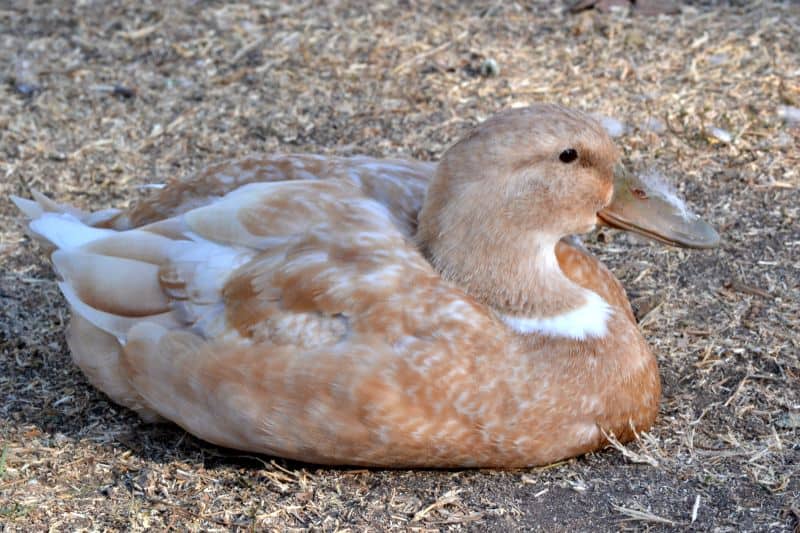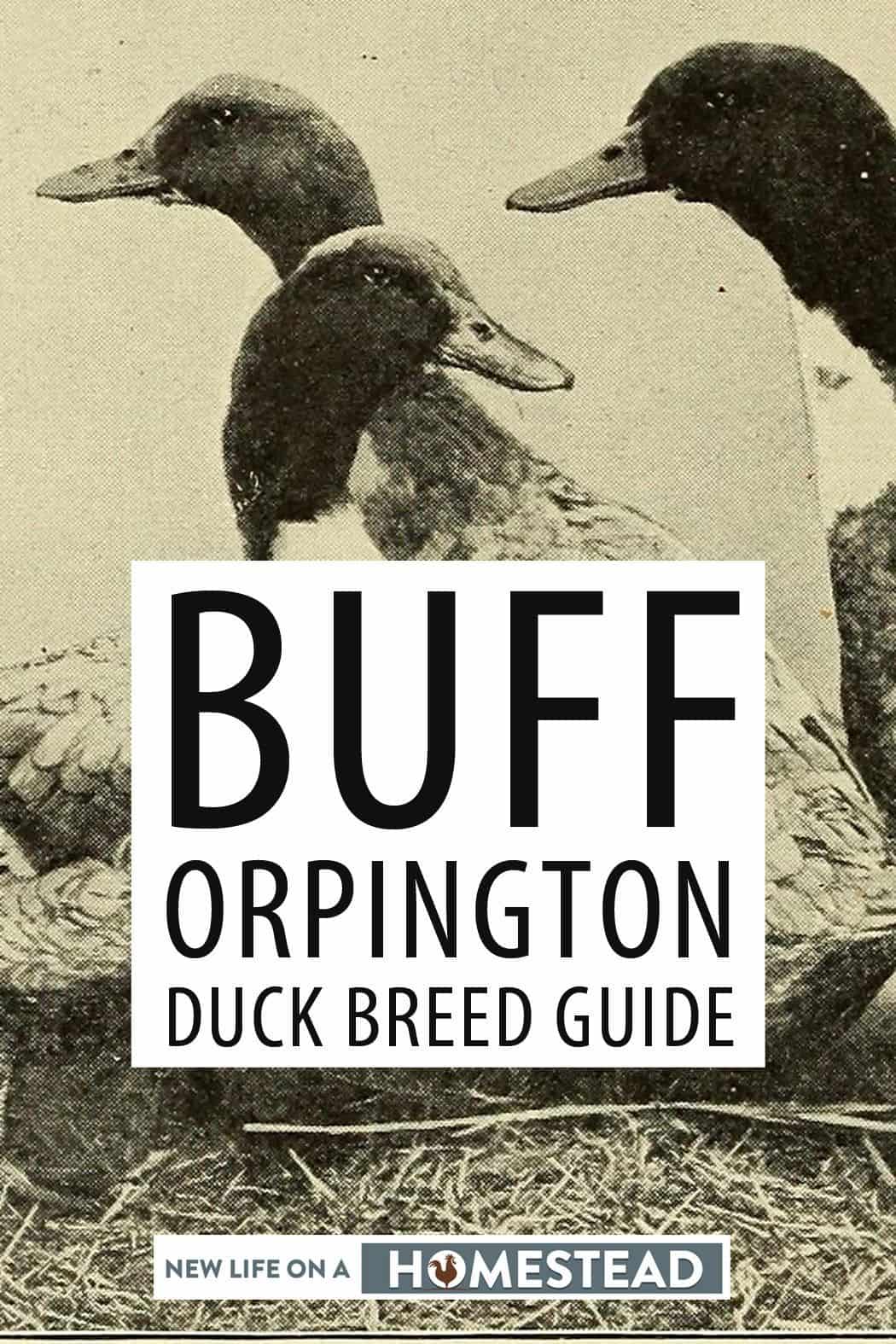Buff Orpington ducks have an extensive history of being both high quality meat, and egg birds. These hardy beauties cannot fly away and can thrive both on large homesteads and in small town backyards.
Ducks of this breed are affable, docile, and bond well with their keepers. In addition to being used just for their looks and friendly nature as pond adornments, just a small flock can easily provide enough eggs and meat to feed a family of four.

Buff Orpington ducks are second to only the Pekin duck breed in popularity when it comes to commercial meat production in the United States.
In fact, in Europe, Buff Orpington ducks might even edge out the famed (and my personally favorite breed) Pekin ducks by chefs in high end restaurants.
Members of this heritage duck breed, like all domesticated breeds, cannot really fly. Buff Orpingtons can get a handful of inches off the ground, and fly maybe one foot forward.
The average lifespan of Buff Orpingtons (sometimes referred to as merely Buffs) is 5 to 7 years.
Buff Orpington Duck History
These meat and egg ducks come from England. William Cook, a highly respected poultry breeder from the Orpington, Kent area, created the Buff Orpington breed.
He crossbred Indian Runner ducks, Cayuga ducks, Rouen ducks, and Aylesbury ducks to create a prime meat and egg duck breed.
Through William Cook’s deliberate and diligent breeding efforts, he created Orpington ducks in the Buff, Blue, White, and Black varieties.
During the early part of the 20th Century, Buff colored plumage was a rampant fashion trend throughout Europe.
Because the White Buff was less popular on garments, this variety of the breed floundered a bit in popularity.
The Buff Orpginton duck breed was standardized by poultry associations in Europe in 1910. The Blue Orpington duck variety was standardized 16 years later.
Cook presented his Buff Orpington ducks at the Madison Square Garden Show in New York in 1908. Just six years later this duck breed was granted status in the American Standard of Perfection poultry books – classified with the label of only Buff.
This is the only known time that a poultry bird breed was classified by its color or type of plumage alone.
Buff Orpington ducks were significantly more popular in Europe than they were in the United States, but these birds are still cherished for their personalities and productivity by keepers in the United States.
The Livestock Conservancy indicates there were only a little more than 1,000 Buff Orpington breeding stock in the whole of North America in 2015.
Most of the flocks kept, according to the domestic waterfowl census survey responses used to determine breeding stock populations, those who kept these lovely birds had flocks of 50 or more in their possession.
The rarity of members of this duck breed can impact selection, availability, and price in some regions.
Physical Attributes Of Buff Orpington Ducks
- Buff Orpington ducks are broad, with a graceful, long and curved neck.
- This breed of duck is classified as being in a “light class” meat duck. They weigh roughly 6 to 8 pounds once they mature. This weight level places them just barely below a medium weight class designation.
- Buff Orpington ducks have an oval head, and a bill of medium length.
- Tails on Buff Orpington ducks are curled in a unique and quite distinctive manner.
- The bill on a hen is brown to orange. Drake bills are yellow.
- Buff Orpinton ducks have a body carriage that is 20 degrees above horizontal.
- Shanks and feet on members of this breed are yellow to orange in color.
- The wings on both males and females are small and short.
- Buff Orpington pin feathers are light in shade, with bugg plumage that can also be fawn brown in hue.
- Hens and drakes both develop buff plumage.
- A mature hens weighs roughly 5 to 6 pounds. Mature drakes typically weigh between 6 to 8 pounds.
- The rapid weight frequently associated with the Buff Orpington breed is one of the reasons they have also been a popular meat duck. A duck of this breed, regardless of gender, can hit butcher weight in just 8 to 10 weeks.
Buff Orpington Personality
- Buff Orpington ducks are not only friendly and docile with their keepers, but with other members of their flock and with other varieties of poultry birds they are kept with.
- Members of this breed, like nearly all types of heritage livestock, are especially hardy. They adapt to climates of both hot and cold equally well and seem to be highly resistant to common poultry parasites.
- I have found Buff Orpington ducks to lack the high startle response common to some duck breeds. This personality trait tends to keep all of the honking and quacking to a minimum – making them a pretty quiet duck breed.
- Buff Orpingtons are superb free-ranging birds. They are capable of foraging for at least half to two thirds of their daily dietary needs when having access to a pond and a spacious roaming area. Their favorite free-ranging treats often include wild greens, tadpoles and young frogs, tiny crustaceans, little lizards, snails, and slugs.
- Buff Orpington hens make attentive mommas. They tend well to their little ducklings, and take the job of teaching them barnyard smarts and free-ranging skills quite seriously.
- Members of this duck breed seem to be very intelligent, which helps with both free range boundary training as well as predator avoidance.
Buff Orpington Husbandry
Keeping this heritage meat and egg duck breed is not harder or easier than keeping any other type of duck. They need a duck house or coop and run that will protect them from both predators and the elements.
Buff Orpington ducks also need constant access to clean drinking water, and water to swim in. A plastic baby pool will suffice if you do not have a small garden pond, or a traditional farm pond.
Ducks should not go without having enough clean water to dip their bills and head into for more than eight hours. Keeping their mucous membranes from becoming dried out is essential to their overall health.
Ducks can eat waterfowl feed or poultry bird feed sold for game birds and chickens. Ducklings should never be fed chick medicated starter, only non-medicated chick starter.
Egg Production
- Hens of this breed typically lay between 185 to 250 large white eggs annually.
- A Buff Orpington hen lays three to four eggs per week, on average.
- Hens of this breed are generally deemed decent egg sitters. But, to ensure you can sustain flock numbers or grow your flock, purchasing an incubator with an automatic turning arm and humidity gauge is still highly recommended.
- Buff Orpington hens can turn broody. When this happens you will have to wrestle eggs from them to either eat or incubate. A Buff hen may be prone to stealing the eggs of other ducks and even chicken hens kept in the same living quarters.
- While a hen of this breed will be protective of her young, she does not tend to go into hysterics if you try to touch and handle the ducklings – as long as you have built up a good level of trust with the flock.
Meat Production
The light colored pin feathers on members of this breed can make cleaning them an easier task.
Although Pekin ducks are most often kept as duck meat birds in America due to their large size and growth rate, the meat on a Buff Orpington duck can be more robustly flavorful and tender.
Breeder Buying Tips
Finding Buff Orpington ducks at the local hardware or agricultural supply store is not likely going to happen.
You will most likely have to find a professional breeder that raises heritage breeds, or pucharge the Buff Orpington ducks (or fertilized eggs) from a large breeder like Meyer Hatchery or Murray McMurray Hatchery, and have them shipped to your homestead.
The time of year you plan to purchase the Buff Orpington ducks or their fertilized eggs greatly impacts availability and even price.
Mature ducks are sometimes available throughout the year but fertilized eggs, ducklings, and juvenile birds are often sold only from spring through the summer or early fall.
If you can find Buff Orpington ducks from a local breeder, or can drive to a large hatchery, choose birds that are neither overly excited nor lethargic, which can be signs of health issues.
The birds should not be either one pound over or under weight and have vibrant eyes that do not look cloudy or watery. Watch how the ducks walk. Make sure there are no deformaities, or signs of weakness.
The feet and legs should be uniform in size and shape, as well. Bills on the ducks you are buying should be attached high on the Buff Orpington’s head and laser straight.
Being able to see the breeding pair that produced the ducklings you are purchasing would be ideal. Also, find out as much information as you can about the average lifespan and egg laying habits of the breeding hen.
If you are going to breed Buff Orpington ducks to sale, keeping consistent health records on the weight, live hatch statistics, egg laying quantity, quality, and active years, may help increase sales while developing a reputation as a top-notch breeder.
If starting a flock of Buff Orpington ducks to use as meat birds, search for a breeding pair or ducklings with as much light or white-colored pin plumage as possible.
Should the ducks be destined for the show ring, search for breeders that have as small a percentage of non-buff plumage as possible.
The effort put into searching for Buff Orpington ducks should pay off in spades. These docile and graceful ducks tend to produce a high quantity of eggs even when hens are as old as four or five.
Their eagerness to interact with each other and willingness to do the same makes Buff Orpington ducks are a great choice for both children involved in 4-H and newbie adult keepers.


Tara lives on a 56 acres farm in the Appalachian Mountains, where she faces homesteading and farming challenges every single day, raising chickens, goats, horses, and tons of vegetables. She’s an expert in all sorts of homesteading skills such as hide tanning, doll making, tree tapping, and many more.

Hello, I enjoyed your site.
I to have buff ducks. I’ve just started an incubator and had a question in regard to the breeding of a buff with a Rouen hen. My eggs are mostly all white and quite large, but none are fertile except one in the bunch. I am not sure of why only one would be fertile. I have 2 Rouen hens and 2 buff hens and 2 male buff. I appreciate any advice you may have to offer, have a blessed day ty
Reading through the duck history on this breed brought back a funny incident back in the 1980’s when I was a 4H Poultry leader. I was manning the booth in the Poultry barn at the county fair one day and a lady came up and said that there was a duck choking on something. I went with her and she showed me the duck. I almost started laughing as it was an Indian Runner duck. I explained to her that the duck wasn’t choking on anything, it was the “natural” posture of that breed of duck. She replied “But it’s making this weird noise when it tries to quack.” I then explained that male ducks don’t “quack” – only females “quack”. The noise the male was making was completely normal.